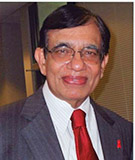
Cancer – What’s the Answer? Part I

One day, my 70-year-old sister called me from India when she casually mentioned about a sort of thickening of the skin over her left breast. “I don’t think it’s anything to worry about, don’t feel any lump or anything like that … may be just a bug bite,” she said. There was no pain or tenderness and she felt fine. But I told her, “I am arranging an urgent consultation with a surgeon in one of the good hospitals there right away,” and I did. The biopsy showed “triple hormone negative carcinoma of breast” (a virulent form of breast cancer)! Soon, she underwent breast surgery followed by chemotherapy and has remained well ever since. It has been 10 years now and she continues to remain cancer-free. Such is the power of early diagnosis and proper management in dealing with this disease.
When a doctor tells the patient, “I am sorry, the biopsy report came back as cancer,” the first reaction from the patient would be, “Oh, my God, this can’t be happening to me! What have I done to deserve this?” Most people think that the diagnosis of cancer is a death sentence because it is still one of the two major causes of mortality and morbidity in the U.S. and maybe in most other countries too. Many are even afraid to pronounce the ‘C’ word! No need to be; the experts believe we are finally winning the war on cancer.
There are two important points for all of us to keep in mind all the time. 1.) Those who are fortunate never to have had a bout of cancer should take every precaution to prevent it. A few simple lifestyle changes would go a long way. 2.) And for those who already had an encounter with cancer, it’s of utmost importance to prevent its recurrence by observing strict compliance with therapy and constant monitoring of the disease. The sooner you start taking the right steps to prevent the disease or a recurrence, the better it is for you to preserve and enjoy good health. And to help you with all these many hospitals are even providing free screening of high- risk patients.
There are several types of cancers that can occur in your body. Literally any organ is susceptible. Unlike in the past, a lot of cancers are curable with proper treatment and most others can be treated and kept under good control, just like some of the noncancerous chronic diseases. You have heard stories of cancer survivors who go on to live their life for years, disease-free. Spectacular new therapies have changed our outlook on cancer and more are on the way. During the next several sessions, we will explore these ideas, including the latest advances in cancer therapy.
What is Cancer?
Our body consists of trillions of cells and these normal cells grow and multiply by a process called cell division in response to the signals from within. As the cells grow old and become damaged and ineffective, new cells are formed to replace them. Normal cells stop growing when they encounter other cells, and they do not move around the body. Cancer cells are different. They are abnormal cells that ignore the commands or signals from within the body. They mutate and keep growing to become tumors and invade nearby areas. They also spread to remote areas, choking the normal tissue and suppressing its function. Our immune system normally eliminates damaged cells, but cancer cells are clever and trick the immune system into helping them to stay alive and even grow wild. And some cancer cells even convince the immune cells to protect instead of attacking them!
Cancer seems to develop from certain changes or mutations occurring in our genes located within the DNA of the chromosomes. These genetic changes can happen because of spontaneous errors that occur as cells divide or from damage to the DNA from environmental influences — like lung cancers from cigarette smoking or skin cancers from excessive exposure to sunlight. Our body normally eliminates cells with damaged DNA before they turn cancerous. However, the body’s ability to do so goes down as we age due to senile atrophy and dysfunction of the tissues. This is part of the reason why there is a higher risk of cancer later in life. And each person’s cancer has a unique combination of genetic changes.
To be continued …
M.P. Ravindra Nathan, M.D., is a cardiologist and Emeritus Editor of AAPI Journal. For further reading, “Second Chance - A Sister’s Act of Love” by Dr. Nathan from Outskirts Press, can be found at www.amazon.com